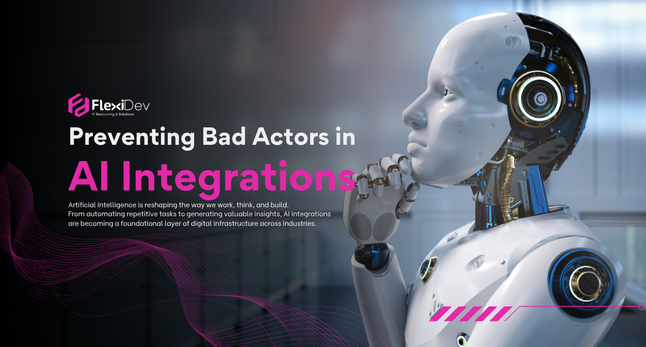
Artificial Intelligence is reshaping the way we work, think, and build. From automating repetitive tasks to generating valuable insights, AI integrations are becoming a foundational layer of digital infrastructure across industries. But as we embed AI deeper into our systems and workflows, we must also address the growing concern of bad actors – individuals or groups seeking to exploit vulnerabilities in AI-powered environments. This equally affects services yet to use AI integrations, which will nonetheless be connected to services that currently do.
Why This Matters
AI is no longer just a tool in the hands of developers or data scientists; it’s being integrated into customer service, healthcare, finance, logistics, and even government systems. These integrations carry real-world consequences when manipulated or abused.
From prompt injection attacks and model poisoning to identity spoofing and misuse of generated content, the spectrum of AI-specific threats is growing – and evolving fast.
The Most Common Threat Vectors
- Prompt Injection & Jailbreaking
Malicious users can manipulate inputs to bypass restrictions in language models which power chatbot and AI-based services to extract sensitive confidential intel. This modified intel may then be shared with third-parties, meaning that your service doesn’t need to be integrating AI to be exposed to AI misuse.
- Data Supply Chain Attacks
Ingested training data can be poisoned or biased, compromising the behaviour of AI systems even before deployment. This can intentionally skew results to benefit a third-party. Open or poorly secured AI endpoints can be exploited to manipulate systems at scale. This is unlikely to be directly detected by the business using these services.
- Lack of Explainability
Black-box models can mask harmful behaviour, making it hard to detect manipulation or unintended consequences. AI models are highly effective, but the mechanisms and logic behind outcomes are rarely in plain view, even for the propriety tenants. For this reason, they are more open to manipulation.

What Companies Can Do Today
1. Build with Security in Mind
Adopt a security-first approach to AI integrations. This means:
- Rate-limiting API access
- Validating and sanitising user inputs
- Logging and monitoring system behaviour for anomalies
2. Testing for Adversarial Use
Include red-teaming and adversarial testing in your development pipeline. Simulate attacks to identify and patch vulnerabilities.
3. Apply the Principle of Least Privilege
AI systems should have the minimum level of access required. Limit what models can retrieve, do, or modify.
4. Ensure Model Transparency and Governance
Use explainable AI (XAI) techniques where possible. Maintain documentation and version control over models and datasets.
5. Educate Your Team
Security isn’t just a dev-ops responsibility. Everyone involved in AI – from product to support – should understand the risks and best practices. Our developers will, as per the norm, keep your tech up-to-date with patches and in-built defences for potential unwanted intrusions.
Moving Forward
When you place a FlexiDev engineer on your team, we ensure an AI which involves explainability, preparation, shared awareness among stakeholders and teams, as well as shared responsibility. Please do reach out to get more context on how to protect your services, going forward, in the context of the AI ecosystems your products operate within currently these days. Connect with FlexiDev for on-demand and quality IT support.



